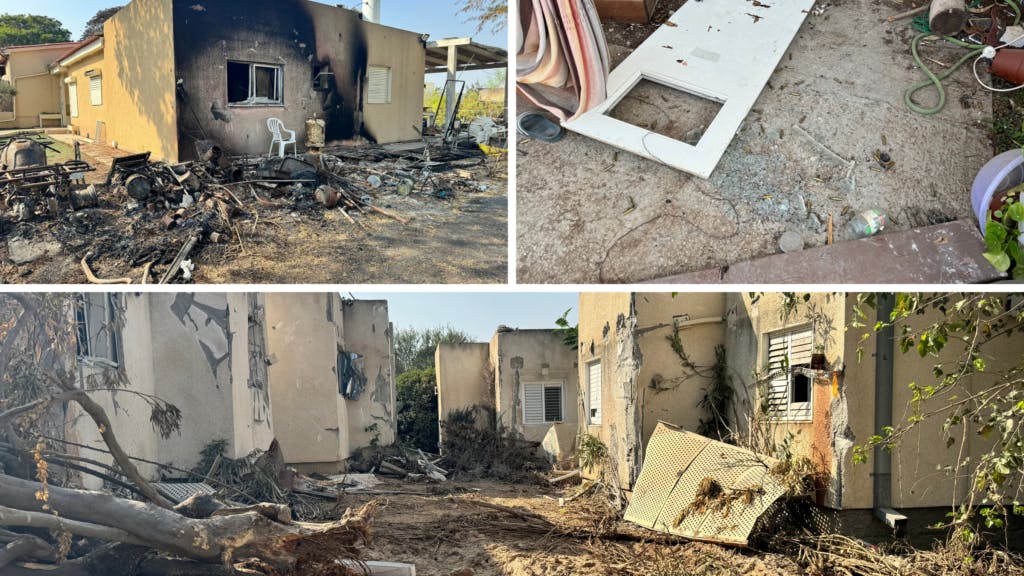Imagine a street lined with a chain of houses, each one as the setting of an unimaginable nightmare.
In one, your family was burned to death. A house over, a grenade exploded in your living room. In another, your sister’s bloodied legs left an impression below the window as she attempted to escape. Down the street, bullets peppered the door of the room you were hiding in. No rescue force came to save you from any of these nightmares and, in each of them, you died.
This is the reality of Kfar Aza, a kibbutz about three miles from the Gaza border where Hamas terrorists entered on October 7 and slaughtered more than 50 people. Twenty people are still missing.
AFTERMATH OF HAMAS MASSACRE ON KFAR AZA, ISRAEL
The Israeli government opened up one of the village’s streets to journalists to view the evidence. Bloodied remnants of terrorists, such as Hamas vests, still litter the ground of the kibbutz, and Israeli mortar fire booms in the background.
Every person on this street died, according to an Israeli Defense Forces official leading the tour. Identifying information such as credit cards, family pictures, laptops, and documents still sit on counters and tables.

Houses in Kfar Aza / The Daily Wire
It doesn’t matter how many videos you’ve watched or photos you’ve seen of the attack. Walls are collapsed, furniture and debris are spilling from homes, bullet and shrapnel holes are everywhere. But worst of all is the pungent smell.
If you’ve never smelled this before, you may associate it with sewage, as I did. But as you walk through the homes and speak to the survivors and first responders, you quickly learn that it’s the smell of death lingering from the many removed bodies.

The IDF told The Daily Wire that there were no survivors on the street pictured above / The Daily Wire
The site has been slowly transforming over the weeks as members of Zaka, the civilian volunteer organization tasked with cleaning up bodies, look for blood and body parts to bury in accordance with Jewish law.
GET 50% OFF DAILYWIRE+ ANNUAL MEMBERSHIPS
One Zaka volunteer says he transported over 70 bodies in his truck on the first day of the attack. More recently, Zaka has been searching for bloodied items to remove and bury, including cutting out pieces of fabric from furniture that is soaked with blood.
Every home looks like the set of a different horror movie. The first house I walked into looked ransacked. Furniture was everywhere and broken, and debris littered the floor. When I looked at the ceiling, it was covered in bullet holes and grenade shrapnel.
The next home I went into is the one that keeps me up at night.
‘FIGHTING LIKE A LIONESS:’ THOUSANDS ATTEND FUNERAL FOR AMERICAN KILLED IN JERUSALEM TERROR ATTACK
It is a one bedroom home where you enter through a tiny kitchen into a living room that has bullet holes in the walls, and was the site of a fire. At the back of the room, there is a door leading into a bedroom that doubles as a bomb shelter — once you enter through the doorway, the first thing that catches the eye is splattered blood on the wall and what looks like the stamp of a bloodied knee of someone trying to climb out the window.

Two Kfar Aza homes, one with shrapnel holes in the ceiling and another with blood on the walls / The Daily Wire
It appears to be a room of a young woman, who had plants and weaved art as decorations on the wall. On her bed, there is a laptop lying on red sheets, both splattered with blood. Only then, when looking down, did I realize I was standing in this woman’s blood.
Maor Moravia, a survivor from the massacre, told us that he hid in his bomb shelter with his wife and children while hearing explosions and gunfire and receiving text messages about the terrorist infiltration. He said they hid for hours in his home, which is one of the last in the kibbutz, until they finally heard terrorists in his neighbors house. After many hours, the army arrived.
Moravia expressed that every person who was murdered was one of his friends, as his village is a tight-knit kibbutz of only about 750 people.

A row of destroyed homes in Kfar Aza, Israel / The Daily Wire
Simcha Greenaman, of Zaka, has been working in Kfar Aza to share the atrocities he witnessed to visitors. In one instance, in Kibbutz Be’eri, just miles away, he said he saw a toddler’s body with a knife through its skull.
Another Zaka member, Mendy Chaviv, who has been cleaning the massacre sites since the first day of the war, said he personally found the body of a young female soldier in a home, with her limbs severed and her blood covering the walls.
MEET THE AMERICAN COWBOYS WHO RUSHED TO ISRAEL TO FILL IN FOR FARMERS CALLED UP TO FIGHT HAMAS
While ducking into partially collapsed homes and letting your imagination unfold, possible scenarios of what collapsed that wall, or charred that room, or caused the wound that led to that splattered area of blood, you realize that these are close-range crimes.
The terrorists who butchered a body or kidnapped your neighbor had to look them in the eye while doing it. This wasn’t soldier versus soldier on a battlefield, or unfortunate collateral damage, this was Hamas bringing nightmares to life and being proud of doing so.

.png)
.png)
.png)

